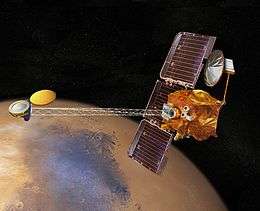NetLander
For late 2007 (or 2009) CNES (the French Space Agency) and ESA (the European Space Agency) had planned to send to Mars a remote sensing orbiter and four small Netlanders. The Netlanders were to have landed in four different Mars locations.
The Landers' mission was to take pictures of the landing site and explore Mars' internal surface and atmosphere. Each of the four landers was to carry instruments for the following measurements:
- Seismometer, IPG, France
- Panoramic camera, DLR, Germany
- Atmospheric sensors, FMI, Finland
- Atmospheric electricity sensor, CETP, France
- geodesic and ionospheric measurements, GRGS, France
- Soil properties measurements, University of Münster, Germany
- Ground Penetrating Radar, CETP, France
- Magnetometer, CETP, France
- Microphone, University of California, Berkeley, USA[1]
The Orbiter's mission was to take pictures from orbit, explore Mars' atmosphere and relay information and images from the Netlanders.
CNES and ESA cancelled this mission because it was too expensive; both agencies have planned to send other orbiters and landers for missions like ExoMars.
The MetNet multi-lander mission to Mars is based on the legacy of NetLander.[2] MetNet is scheduled for launches in 2011–2019.[3]
The NetLander design has been examined as the basis for a small Solar System body lander, such as a comet.[4]
References
- ↑ Counil, J. L.; Ferri, F.; Lognonne, Ph.; Marsal, O.; Rocard, F.; Bonneville, R. (2001). The Netlander Mission: A Geophysical Network aimed at investigating Mars Atmosphere, Sub-Surface and Deep Interior (PDF). Conference on the Geophysical Detection of Subsurface Water on Mars. Houston.
- ↑ MetNet The New Generation of Atmospheric Observation for Mars (PDF). European Planetary Science Congress. 2008.
- ↑ "MetNet Mars Mission". Finnish Meteorological Institute.
- ↑ Ulamec & Biele - From the Rosetta Lander Philae to an Asteroid Hipper: Lander concepts for small bodies missions
See also
- ExoMars (Europes big Mars mission in the 2010s)


.jpg)
.jpg)